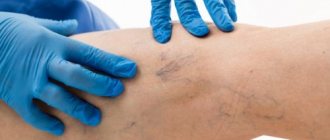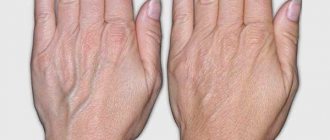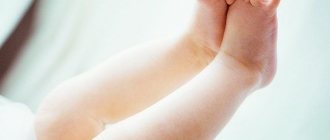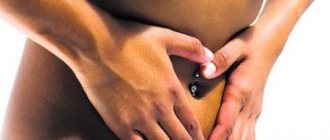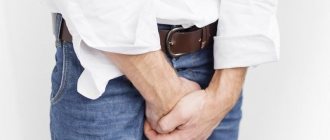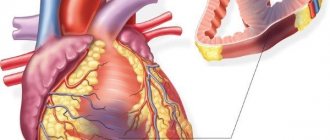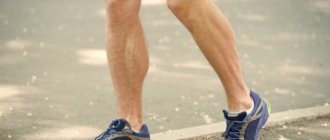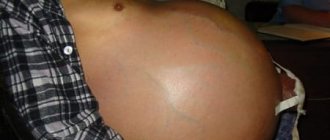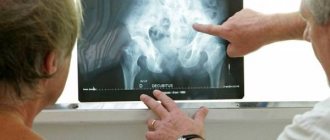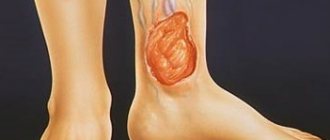Men are less likely to suffer from such a pathology as varicose veins, however, it does not completely bypass them. As a rule, representatives of the stronger sex seek medical help only when the disease becomes severe, which significantly complicates therapy. Today, doctors know almost everything about varicose veins, and if you contact them in a timely manner, they will always provide qualified assistance.
Men often ignore the first symptoms of the disease, considering them just a cosmetic defect. The understanding that something is wrong with health comes only at the moment when large inflamed venous nodes appear on the legs, causing pain and suffering. Particularly resistant patients go to the doctor only after non-healing trophic ulcers appear on their legs.
The danger of varicose veins
Everyone needs to know why varicose veins in the legs are dangerous in men. At first glance, the disease seems to be just a cosmetic defect, but in reality it is much more serious. Varicose veins in themselves do not pose a threat to the life or health of the patient, but thrombophlebitis developing against it is a serious cause for concern! There is a chronic form of thrombophlebitis and an acute one. Its most dangerous complication is the detachment of a blood clot that can block the pulmonary artery (pulmonary thromboembolism).
In the future, venous pathology carries the following risks to health and life:
- thrombosis - when the veins dilate, blood begins to stagnate, which provokes the appearance of blood clots. When a blood clot breaks off, a blockage of a vessel occurs, which can lead to death;
- insufficient blood supply to the legs - with advanced varicose veins leads to the development of trophic ulcers, severe inflammation, tissue necrosis and gangrene;
- decreased performance – with severe pathology, edema of the lower extremities develops, which seriously impairs performance, gradually leading to disability.
In the absence of adequate treatment, there is a high risk of vein pathology transferring to the groin area, which can lead to reproductive dysfunction and diseases of the genitourinary system.
Why is it dangerous?
Varicose veins place additional stress on the heart muscle. Due to decreased coronary blood flow, myocardial weakness develops.
An advanced disease can provoke:
- the occurrence of trophic ulcers on the lower extremities due to impaired blood circulation,
- spread of eczema,
- development of thrombophlebitis and phlebitis.
A blood clot detached from the wall provokes serious consequences in the form of embolism (blocking) of the pulmonary artery. In this case, death occurs instantly.
With varicocele, potency decreases, problems with reproductive function appear, and a man may be diagnosed with infertility.
As varicocele progresses, other serious pathological conditions may develop:
- dropsy of the testicle (hydrocele),
- testicular atrophy,
- vascular perforation,
- venous thrombophlebitis,
- thrombosis of the penis.
Reasons for the development of the disease
Without prerequisites, varicose veins do not expand. The causes of varicose veins in men are no different from those that cause the disease in women. The following provokes the development of pathology:
- hereditary weakness of the venous valves is the main factor causing the appearance of varicose veins. If it is present, special regular monitoring of the condition of the legs is required;
- frequent constipation - with this digestive disorder, the pelvic veins are overloaded, which causes gradual stagnation of blood in the legs;
- excess weight - due to overload of the legs, blood stagnation develops, which in turn leads to pathological stretching of the veins without the possibility of recovery;
- prolonged excessive physical activity - during this, blood circulation in the tissues is disrupted and the full outflow of blood from the legs stops. Because of this, stagnation develops, which causes the disease;
- sedentary or standing work - in such a situation, due to compression of the veins over a long period of time, severe blood stagnation develops, deforming the venous valves and stretching the walls of blood vessels;
- smoking – with prolonged use of nicotine, toxic substances enter the body, which thin the venous walls and lead to a loss of their elasticity;
- alcohol abuse – the effect is similar to nicotine.
In the complete absence of predisposing factors, varicose veins rarely occur. The pathology mainly affects people over 45 years of age.
Varicose veins on the legs in men: causes
To resist pathology, you should have information about it. The causes and signs of varicose veins on the legs of men are of great importance in this fight.
!
First of all, it is worth noting the hereditary factor.
It is possible to inherit varicose veins, as well as the characteristics of the connective tissue that make up the vascular walls. The main provoking factors for the development of pathology in men also include:
- bad habits - smoking and alcohol addiction;
- excessive passion for strength training;
- passive lifestyle;
- long-term driving;
- obesity;
- lack of diet and daily routine;
- chronic diseases of the kidneys, liver, etc.
All of us know that experiences weaken the body's protective functions. Can we say that varicose veins in men also arise from nerves? Such a direction of medicine as psychosomatics claims that in 75% of cases of the development of cardiovascular diseases, nerves play an important role. Therefore, an unstable emotional background may be one of the factors provoking the development of varicose veins.
Expert opinion
The etiology of vascular diseases is not fully understood. Therefore, the true list of causes and factors influencing the development of the disease can be large. Varicose veins in the legs are considered to be a polyvalent disease. In this regard, it is important to know what symptoms it has. This will allow you to see a doctor in time and receive treatment.
Vascular surgeon, phlebologist
Osipova Ekaterina Yakovlevna
Let us recall that the negative consequences of the development of varicose veins on the legs in men are formed mainly due to a late visit to a specialist, including due to ignorance of the clinical picture of the disease.
Signs of varicose veins on the legs
Manifestations of varicose veins
In men, symptoms of varicose veins appear early, and it is important to recognize them promptly. Representatives of the stronger half rarely pay attention to the first manifestations, and therefore for them the acute symptoms of the disease always come as a surprise. About pathological dilation of veins they say:
- spider veins - they are the first sign of the disease. They appear on the legs in the form of a peculiar pattern - cobwebs. From this moment it is necessary to begin treatment of the disease. As it progresses, bulging of blood vessels and increased severity of stars are observed;
- goosebumps in the extremities - due to deterioration of blood supply, a feeling of goosebumps on the skin is often observed, sometimes they can turn into convulsions, mainly at night;
- pain - unpleasant sensations appear along the diseased vein after prolonged physical activity or being in a position that is uncomfortable for the legs. With the further development of the disease, night pain in the legs is also observed, which can be prevented only by raising the legs higher than the body, for example, by placing a pillow or cushion under them;
- swelling – at first swelling appears only in the foot area, and as the disease develops it rises higher. At first, swelling appears only after prolonged physical activity and goes away if you give your legs rest. Further, the swelling becomes permanent, and even long rest does not eliminate it.
- darkening and thickening of the skin;
- constant low temperature of the feet;
- deterioration of sensitivity of the feet and legs;
- formation of trophic ulcers.
Symptoms of varicose veins
Many patients seek qualified medical care only 10-15 years after the first signs of varicose veins appear, when their condition becomes so bad that it interferes with normal daily life, not to mention full-time ability to work.
Treatment of swollen veins on the arms of men
Swollen veins in the arms most often indicate the onset of varicose veins, so neglecting such “bells” is highly discouraged, because this is the body’s natural signal of distress.
For most people, the arms, as well as the lower limbs, are constantly exposed to physical stress, or remain in a lowered state for a long time.
This is what leads to venous stagnation of blood. Initially, the disease manifests itself on the hands, then it gradually rises higher and higher towards the elbow.
Of course, not in every case the cause of swollen veins in the arms of men and women is varicose veins. Sometimes this phenomenon is due to the thinness of a person and does not pose any danger to him.
However, to definitely answer this question, you need to visit a phlebologist and possibly undergo several examinations.
Causes
As a rule, swollen veins on the arms of men are a consequence of varicose veins. With varicose veins, the main impact falls on the vessels and veins, which are natural “highways” for blood. They carry blood to the heart.
But if a person has varicose veins, the vessels and veins dilate to a large extent due to stagnation of blood in them (their lumen increases), and their walls, on the contrary, become thinner. In addition, the swelling is often supplemented by venous nodes (it looks like a subcutaneous lump).
If these symptoms are detected, it is immediately recommended to seek help from a phlebologist. Here are the two main causes of swollen veins in the arms of men:
- Thinness and thin skin. Most often, swollen veins on the body of a thin woman or thin man do not pose any danger and are not a pathology. In such cases, the reason for this phenomenon lies in the lack of subcutaneous fat in thin people. Sometimes veins are visible because the skin is too thin. In all the cases described above, swollen veins do not pose a threat to humans, but their presence may indicate a lack of the most important structural element in the body - collagen.
- Excessive loads. In people who regularly expose their hands to excessive physical activity, sooner or later the veins begin to swell. This happens because when the hands are overloaded, additional blood flows to them and stagnates in the vessels and veins. A similar deviation often develops among loaders and professional bodybuilders, first on the hands, and then throughout the entire area of the arms.
The most common cause of all described is varicose veins. It is varicose veins that lead to disruption of the valves in the vessels and veins and a deterioration in blood flow to the heart. As a result, blood stagnates in the veins and increases pressure in them, which leads to bloating.
After some time, pain is also added to the swelling of the veins in the arms of men, due to the fact that damaged valves interfere with the flow of blood to the heart. Because of this, the pressure in the veins increases even more, and the functioning of the valves is disrupted faster and with greater intensity.
Treatment
If the veins are just starting to swell, you can try to stop the development of the disease with hirudotherapy. This is a proven and effective leech treatment. More than one generation of people has tried it on themselves.
The saliva of medicinal leeches contains a special enzyme that has a positive effect on blood vessels and helps them return to their previous form. To improve the well-being and appearance of your hands, only 5-6 sessions are required.
To consolidate the effect, it is recommended to repeat the treatment once a quarter.
Modern medicine has come quite far in the treatment of swollen veins in the arms, so today there are many ways to combat this disease. Here are the main, most effective treatment methods:
- Sclerotherapy (a procedure during which a special sclerosant is introduced into the vessel, gluing it and promoting its further resorption);
- Laser treatment (a method of influencing blood vessels with light energy from laser radiation);
- Phlebectomy (bloodless and painless mechanical removal of veins without incisions);
- Taking medications (regular use of phlebotonics, anticoagulants, antioxidants, etc.);
- Ultrasound treatment (exposure to swollen veins with ultrasonic waves at frequent intervals);
The choice of treatment method largely depends on the condition of the veins, so you rarely have to choose on your own. As a rule, the doctor, based on the test results and the collected medical history (patient survey), independently selects the most appropriate way to combat the disease.
Read on topic: Varicose veins on the penis
Traditional treatment
To treat swollen veins in the arms of men at home, there are a huge number of different folk methods.
However, it is immediately worth noting that it is not possible to overcome the disease with traditional medicine alone. It is best to do this in combination with drug therapy and adjustment of the work regime (stress on the hands).
Here are the main, time-tested folk methods that help cure swollen veins on the arms of men:
- In order to relieve inflammation in swollen veins and cope with pain, it is recommended to apply purple lilac leaves dried in the shade to the affected areas of the skin (white lilac leaves cannot be used) and wrap your hands in a warm cloth at night. After just 3-5 days of regular compresses, you can feel significant relief.
- It is imperative to consume one teaspoon of chopped nutmeg every day. It perfectly strengthens the vascular wall.
- Another proven remedy is horse chestnut tincture. To prepare it, you need to add about 50 grams of pre-crushed fruit or horse chestnut flower to half a liter of high-quality vodka. This mixture should be infused in a dark and warm place for 2 weeks, shaking daily. The finished medicine should be taken several times a day, 30-40 drops, for a month.
- Rubbing swollen veins with a mixture of vegetable oil and alcohol is no less effective. This must be done 2 to 4 times a day. The components must be mixed in a 1:1 ratio. You can even make night compresses with this mixture.
- You can use wild rosemary tincture, it also helps against thrombophlebitis. To prepare it, you need to chop the wild rosemary root (half a faceted glass) and pour half a liter of 95% acetic acid into it. It is recommended to rub the tincture, infused for 4-5 days, into the diseased veins several times a day.
- Vinegar can additionally be consumed internally 2-3 times a day, after diluting it in chilled water (1 large spoon of vinegar per 200 milliliters of water). To achieve maximum effect, it is also recommended to rub this solution into swollen veins.
- To prepare the following mixture, you need to have rye flour (100 grams), several large spoons of finely grated horseradish root and 50 milliliters of vegetable oil. All these components must be mixed and compresses made with them up to 3 times a day.
- Additionally, you can drink chestnut decoction. To prepare it, you need to pour 3 small spoons of fresh leaves with a glass of boiling water and leave for half an hour. The strained product should be drunk 1 large spoon three times a day.
Read on the topic: Varicocele in a child: what to do?
It is mandatory, in addition to folk and drug treatment, to adjust the load on the upper limbs and normalize working conditions (change jobs, if possible). It is also useful to exercise.
Prevention
When you notice the first signs of bulging veins, it is necessary to minimize the load on your arms, and also forget about carrying and lifting heavy loads for a long time.
You need to make it a habit to do general strengthening exercises with emphasis on your hands every day immediately after getting up. Exercise should help blood flow out of your hands. After charging, it is useful to take a contrast shower, or at least give it to your hands if you don’t have time.
You also need to adjust your daily diet to include fresh fruits and vegetables. Such products contain the most microelements that help strengthen veins and blood vessels.
By following these simple recommendations, you can prevent the development of this unpleasant disease. Be healthy and don't get sick!
In the early stages of the disease, when it is just beginning to manifest itself, it is recommended to use “Zdorov” Cream for varicose veins. The result of its use will not take long; after 3-4 weeks, the symptoms of varicose veins will disappear completely, and the pain and heaviness in the legs will go away immediately after the first use of the cream.
Source: https://varikoz24.com/pochemu-poyavlyayutsya-vzdutyie-venyi-na-rukah-u-muzhchin.html
How is diagnostics carried out?
To make a diagnosis, you need to visit a phlebologist, who, after a visual examination, will make a primary diagnosis. Next, the specialist will refer you for an ultrasound examination of the veins. This procedure is similar to ultrasound, but the graphics show not only the tissue, but also the speed of blood flow and its quality. Additional examinations are prescribed less frequently, since the signs of varicose veins are very clear and obvious. Among them:
- CT scan;
- CT angiography;
- coagulological blood tests.
Symptoms of the disease
The disease does not have standard signs that may indicate venous insufficiency. Symptoms of varicose veins in men’s legs depend on many factors, the main one of which is the degree of damage to blood vessels and veins. Depending on the severity, the symptoms may vary and may be less or more severe. External signs of varicose veins in men differ due to the presence or absence of complications and the location of the affected area.
Common signs of varicose veins in men include the following:
- The skin on the legs changes color to pale bluish;
- In the evenings, there is heaviness and fatigue in the legs;
- Feeling of fullness in the lower extremities;
- Swelling of the legs in the evenings, disappearing after a night's rest;
- Spider veins and spider veins appear on the surface of the skin;
- Skin sensitivity disorders.
These signs of vein damage are often observed by men in the early stages. A photo of the initial stage makes it possible to clearly see the manifestations of the disease and not miss its development. If treatment is not treated in a timely manner, they begin to worsen, and the symptoms manifest themselves more clearly:
- Painful sensations in the legs;
- Varicose dermatitis;
- Severe swelling;
- Eczema;
- Trophic ulcerative lesions;
- Darkening of the skin;
- Deformed veins and vessels.
In men, varicose veins can develop not only in the lower extremities, but also in the scrotum. This pathology is called “varicocele”. It manifests itself in the form of asymmetry of the scrotum, dilation of the veins of the spermatic cord, determined by palpation, nagging pain in the scrotum area.
Varicocele affects spermatogenesis, since venous insufficiency in the testicle leads to increased temperature in it. If a man does not consult a urologist or phlebologist on time, complications may arise and surgical intervention will be required.
Treatment
Currently, there is no effective conservative therapy that can cure varicose veins. It is carried out in combination with surgical treatment methods and is designed to improve the patient’s quality of life and slow down the progression of the pathology.
All therapeutic actions pursue the main goals:
- Relieving symptoms of chronic venous insufficiency.
- Removing the manifestations of valve insufficiency - because of it, blood stagnation occurs, as the valves lose their ability to control blood flow.
- Avoiding the development of complications - the main consequences are tissue necrosis and sepsis due to infection of tissue at the site of the ulcer.
- Prevention of relapse of the disease.
With rapidly progressing varicose veins, its treatment is only possible through surgery. However, before surgery, conservative therapy is still indicated to improve the patient’s condition. Treatment, as a rule, is selected individually, depending on the patient’s condition. The goal of therapy is always to reduce the lumen of the diseased vessel to eliminate congestion in it.
Treatment of varicose veins
As with symptoms, treatment principles directly depend on how much varicose veins have progressed. Here it is important to understand that conservative therapy bears fruit mainly at the first, sometimes second stage of the disease, but otherwise, conservative treatment methods mainly contain the disease, but do not make it possible to completely get rid of varicose veins. However, it is worth considering a wide range of methods to combat pathology.
Conservative therapy
For treatment with conservative methods, an integrated approach is very important, which primarily involves adjusting nutrition, as well as changing lifestyle.
In terms of nutrition, it is important to limit the consumption of junk food, fatty and fried foods, sweets in large quantities, and minimize salty, spicy and sour foods, as all this contributes to fluid retention in the body and impairs the outflow of lymph.
As for lifestyle adjustments, you need to try to move as much as possible, but not overload your legs. Do light sports, take regular walks, if you have to sit a lot at work, do a warm-up every hour. It is also very important to eliminate bad habits, stop smoking and limit alcohol consumption as much as possible.
Drug therapy
Without the use of certain medications, complete treatment is impossible, therefore, when contacting a phlebologist, a specialist may prescribe medications from the following groups:
- Anticoagulants - change the composition of the blood, reducing its viscosity, which improves blood circulation and prevents the formation of stagnation of blood and lymph.
- Venotonics - as the name should suggest, drugs in this group improve vascular tone. In turn, this also helps improve blood circulation, but it is based on a different principle of action.
- As a symptomatic treatment, ointments from the NSAID category are prescribed, which reduce pain and stop the inflammatory process, and special ointments for varicose veins are prescribed, eliminating swelling and other symptoms.
- Also, as part of conservative treatment, wearing compression garments is mandatory; it prevents the progression of varicose veins and improves the patient’s condition in general.
Conservative therapy
Conservative treatment begins after the patient first seeks medical help.
Compression treatment is used first. Its essence is to create an artificial external support corset for the veins, which will prevent their protrusion and promote better lymphatic drainage. To do this, use tight bandaging with an elastic bandage or special compression garments. You should not prescribe such underwear for yourself, as there are contraindications for its use.
Medicines are prescribed by a phlebologist depending on the degree of damage to the veins and the course of the disease. When the venous bed is significantly damaged by the disease, the most powerful phlebotropic drugs are used in preparation for surgery.
To reduce the risk of blood clots and improve blood flow from the lower extremities, the use of anticoagulants and antiplatelet agents is indicated. Such drugs include:
- aspirin,
- clexane,
- fraxiparine.
The disease cannot be eliminated without the use of venotonic drugs. This medicine is available in the form of ointments, gels and tablets for oral use. Venotonics are almost never an injectable product. Classic drugs are prescribed, such as Troxevasin, Venarus, Detralex, Phlebodia, etc.
Treatment of minor inflammation of the veins is carried out with medications without surgery. To normalize the patient's condition, the use of non-steroidal anti-inflammatory drugs is indicated. Additionally, to obtain results as quickly as possible, gels and creams for topical application are also recommended. Among them are anticoagulants (heparin ointment). In the presence of infections, antibiotics are included in therapy. Acting directly on the inflamed area, they bring quick relief, relieving unpleasant symptoms.
Treatment of male varicose veins
Depending on at what stage of varicose veins a man turned to the help of specialists, there are three treatment methods - let’s look in more detail at what they are and how they affect the affected vessels.
In the case when the patient comes to a medical institution at the first stage of the disease, the phlebologist will prescribe him a complex of drugs with a venotonic effect of medications and various ointments. This treatment is relatively easy and completely painless.
The goal of treating the initial stage of damage to the male veins is to narrow their lumen and restore the function of valve closure. To quickly achieve the desired effect, in addition to medications, elastic bandages are also used; in a supine position, they are applied to the legs, and can also be successfully replaced with stockings or tights made of special medical fiber with a tonic effect.
However, the basis for the treatment of the first stage of varicose veins is the use of medications that restore blood circulation by reducing its density. The drugs relieve acute manifestations of the disease, prevent the formation of thrombophlebitis and thromboembolism, and generally have a significant beneficial effect:
- Tones the walls of venous vessels;
- Increases the strength of capillaries;
- Prevent lymphostasis
- Stabilize microcirculation
- Normalize blood properties
- Relieves inflammatory manifestations
- Prevents the formation of blood clots in veins
To relieve the symptoms of varicose veins in men and stabilize the general condition of this disease, specialists use medications with components of plant origin. Their advantage is the high content of biologically active substances: flavonoids, saponins, coumarins, which have antiplatelet properties.
If the condition of the circulatory system is complicated by the presence of blood clots, the doctor prescribes medications containing antiplatelet agents - their healing effect is the gradual dissolution of the formations. In particular, heparin contained in heparin ointment has such properties. Also, to ensure free microcirculation, phlebologists recommend the following medications:
- Detralex
- Troxevasin
- Anavenol
Due to the significant content of the active substances diosmin and hesperidin, the preparations Detralex and Venarus have a powerful healing effect on the walls of vessels affected by varicose veins. Medicines based on horse chestnut (Aescusan, Escin), as well as drugs with bioflavonoids (Anavenol, Troxevasin), are also common. Inflammatory processes in tissues are relieved by corticosteroid hormones and drugs based on diclofenac. Preparations based on diosmin alone, Phlebof, Vasoket, Diosmin and others like them, are slightly inferior in effectiveness and therefore less in demand.
The medicine is selected only by the attending physician individually for each patient
Surgical treatment methods
However, as we found out earlier, minor defects of the venous vessels in the legs rarely become an argument for starting treatment, and patients often come to a specialist in the later stages of the disease. Of course, in such cases, varicose veins in men on the legs take on more serious forms, in which traditional treatment with venotonic medications and ointments does not bring any effect, as does knitted compression underwear. Therefore, treatment of male varicose veins is carried out primarily by surgery. To limit yourself to minor intervention and ensure a minimum rehabilitation period, so-called gentle or minimally invasive therapy methods are used.
- Laser coagulation of vessels affected by varicose veins - it consists of thermal exposure of the vein wall with a laser beam, which removes stagnation of blood in the veins.
- Phlebectomy is an operation to remove part of a pathologically dilated vein.
- Radiofrequency coagulation – getting rid of varicose veins in the saphenous veins of the legs.
- Sclerotherapy is the injection of a substance into a varicose vein that “glues” the damaged vessel.
It is the sclerotherapy technique that is most often practiced in the treatment of male varicose veins due to its high degree of effectiveness and ease of use. The doctor fills the vessel affected by varicose veins with a sclerosant substance. Thus, the pathological vein is excluded from the circulatory system, gradually forming fibrous tissue.
Symptoms of varicose veins in men are relieved using a laser: under ultrasound control, the vessel is exposed to a laser beam, as a result of which the lumen of the vessel narrows and the walls stick together. In this case, blood circulation in the extremities does not stop, but passes through the remaining healthy blood vessels.
Although varicose veins are a surgical disease, with timely intervention by phlebologists, the course of the disease can be stopped at the initial stages in order to avoid any of the listed operations. In this case, it will be sufficient to carry out general strengthening and supportive measures.
- Say goodbye to bad habits, especially such as smoking and alcohol abuse
- Organize a balanced work and rest regime, adjust the diet, and, if necessary, change the place of work with more acceptable conditions, for example, excluding increased physical activity or a static position.
- To reduce body weight if you are overweight, before doing this it will be necessary to determine the cause of obesity, and then begin to lose weight.
- Make it a rule to wear compression underwear - tights, knee socks, pants made of specialized support knitwear. This measure will reduce the load on pathologically altered veins and relieve swelling.
The type of compression garments and the degree of compression can only be selected by the attending physician.
Traditional methods of combating varicose veins in men
It is worth recognizing: not everyone, upon detecting symptoms of varicose veins, will decide to undergo surgical intervention.
Also, not everyone wants to take expensive medications for a long period. Therefore, when choosing how to treat varicose veins, men have an alternative answer: various traditional medicines come into play. Specialized websites are replete with all kinds of recommendations for alternative medicine - you just need to select a few that are most acceptable for yourself and begin experiments on improving your own health. However, you need to be aware: treatment with folk remedies brings the desired results only when the first symptoms are detected, when the disease is at an early stage of development.
In such a situation, self-medication at home using simple and accessible means can indeed give positive results. The main method consists of preparing infusions from medicinal herbs that have a beneficial effect on blood vessels. Some men prefer drugs with the active substance from horse chestnut, but their use is possible only after mandatory consultation with a phlebologist. Also common are the use of aspirin, heparin-based ointment, and self-prepared garlic remedies.
We can conclude: effective methods that defeat early varicose veins in men on the legs are phytotherapeutic or based on herbal remedies. Here are some of them:
- rubbing with alcoholic infusion of horse chestnut;
- medicinal foot baths made from herbal infusions, as well as taking decoctions of them internally. The most effective will be nettle, knotweed, oak leaves, string;
- lotions made from strong tea leaves and oak bark for the formation of difficult-to-heal trophic ulcers - these natural antiseptics will have an astringent effect and dry out the lesions formed on the skin;
- For several weeks, you can rub an alcohol infusion based on Kalanchoe into the lower extremities.
It is important not to overuse alcohol-based tinctures, otherwise they can only worsen the situation.
In addition to herbal treatments, the treatment of varicose veins on male legs includes gymnastic exercises - many of them are widely known to people and have been used for a very long time. How to treat varicose veins in men with physical activity?
Exercises that provoke the outflow of blood from pathologically altered veins are especially effective. A good example is the following complex: in a lying position, the left and right straight legs are alternately raised up, after which the foot is stretched to the limit, followed by relaxation.
It is worth noting: for male varicose veins, any physical exercise in which you will give your legs an elevated position will be appropriate - doctors especially advise performing these movements in the evening, when activity will relieve the fatigue accumulated during the working day.
Let us remind you: all this is applicable only in the very first period of the disease - when the primary symptoms of varicose veins in men are noted. If the vessels are in an advanced state, you will not receive a therapeutic effect, but the disease can progress to a severe stage, when the situation can only be corrected by surgery. Is it worth risking your precious health? In any case, making an appointment with a qualified phlebologist will not be superfluous: a specialist will accurately assess your condition and prescribe the correct recovery method.
Measures to prevent male varicose veins
However, each of us has the surest way to completely eliminate the disease, and therefore avoid the financial and time costs of treatment. Varicose veins in men on the legs will not threaten you if you strictly adhere to simple preventive recommendations in your life.
- Refrain from smoking and drinking alcohol
- Avoid excessive stress, be it lifting weights, prolonged static positions, or strength sports (for example, bodybuilding)
- Buy loose shoes to wear
- Fill your day with movement: walking, cycling, swimming in the pool, and performing physical therapy exercises are great options.
- When working sedentarily, give your legs a break during the working day: get up and walk around every hour, rising alternately on your heels and toes, this will restore slow blood circulation
- If you have a genetic predisposition to varicose veins, use medical compression garments and take preventive doses of venotonic drugs
- Give your feet contrasting baths made from decoctions with a tonic effect on blood vessels
- Avoid going to baths and saunas - these procedures significantly dilate the walls of blood vessels, causing swelling and venous stagnation
- At the first symptoms of the disease, be sure to contact a specialist who will prescribe treatment in a timely manner and stop the development of such a dangerous and insidious disease as varicose veins.
There are wise recommendations regarding diet: refrain from sausages, steaks, smoked meats, canned foods, spicy, fatty and heavy foods. All this can be replaced with fruits, vegetables, fresh herbs, potassium-rich dried fruits, and calcium-rich cottage cheese. It is also welcome to include seafood in the menu, take fish oil, and eat seaweed. To strengthen the walls of blood vessels, add chokeberry and sea buckthorn juices to your diet - they contain the substance rutin, which restores the health of blood vessels.
The recommendations presented in the article are guaranteed to allow men to avoid the problem of varicose veins in the legs and remain active for many years.
Invasive therapy
Treatment with invasive methods is used both at the initial stage of the disease and in its advanced forms. At the onset of pathology, low-traumatic puncture sclerotherapy is performed. With it, the diseased vein is turned off from the circulatory system without removing it.
Sclerotherapy of veins of the lower extremities
If a severe form of varicose veins is diagnosed, then surgical removal of the diseased vein is indicated - phlebectomy. Along with it, conservative treatment is also carried out. Phlebectomy is performed in 4 stages:
- eliminating the source of revlux;
- removal of the saphenous vein;
- removal of varicose tributaries;
- dissection of perforating veins.
Removal of a diseased saphenous vein can be performed in almost any hospital, since it does not require special equipment. All general surgeons easily cope with this work. Low-traumatic interventions are usually carried out only in large clinics and specialized centers.
If it is not possible to visit a phlebologist, and problems with the veins have appeared, treatment will be prescribed by a surgeon or therapist. Their knowledge is sufficient to select medications and determine the patient’s condition.
Varicose veins in men: symptoms and treatment
The disease that will be discussed in the new material is considered quite dangerous. In this case, as a rule, varicose veins are diagnosed in women. Indeed, varicose veins are observed in almost every third woman, and the reasons are often hormonal contraceptives, wearing high-heeled shoes or tight underwear, and pregnancy.
Therefore, many people have formed the opinion that men do not face exactly the same problem. In fact, this is far from true: doctors note that the disease can affect representatives of any gender and age, including men (according to statistics, this is every fourth). Of course, the disease has its own characteristics. For example, the lesion mainly affects the legs. Well, the essence of the problem is that the veins lose their elasticity, swell, expand, become more tortuous, and this can be seen just by looking at the patient’s legs.
Prevention
Preventive measures, even with a hereditary predisposition to the disease, help protect the veins in the legs from pathological expansion. If a man follows the recommendations, then even with hard work he will be able to avoid varicose veins. Prevention includes the following actions:
- to give up smoking;
- avoiding excessive consumption of alcoholic beverages;
- compliance with the drinking regime - you need to drink 2 liters of clean water per day, not counting liquid food. This ensures normal blood viscosity;
- active lifestyle;
- maintaining normal body weight;
- using an elastic bandage to support veins when lifting heavy objects;
- during long trips in transport and airplane flights, it is necessary to periodically stand up or stretch your legs, promoting lymph flow;
- providing the legs with proper rest in a supine position for at least 1 hour a day, not counting the period of sleep.
Remember that you should not ignore the first manifestations of the disease, considering them only a cosmetic defect. If therapy is started in a timely manner, then there is every chance of getting rid of the disease or stopping its further development.
Diagnostic measures
If a man notices dilated veins in his legs, it is important to immediately contact a medical facility. At the appointment, the doctor asks the patient how long ago the unwanted symptoms appeared, and also asks additional questions that will help identify the causes of the disease. Next, the physician begins a visual inspection and palpation of the affected areas. At the end of the diagnosis, the patient is sent for examinations such as:
An ultrasound is prescribed by a doctor to make a more accurate diagnosis.
- dopplerography;
- ultrasonography;
- phlebography.
Return to contents
Symptoms of pathology
The initial stage of the disease can occur in a latent form. Over time, the signs become more pronounced and appear in:
- The appearance of vascular mesh with a bluish tint.
- Pain and discomfort in the legs.
- Heaviness, difficulty walking.
- Tingling, sometimes itching.
- The occurrence of cramps and numbness.
- Swelling. First in the area of the feet, gradually spreading throughout the leg. In the later stages, swelling does not go away even after a long rest.
Symptoms may worsen with exercise. When your legs are raised up, it becomes easier. In later stages, lumps, peeling skin, ulcers appear on the legs, veins swell, and the pathology can spread to the groin area or pelvic organs.
Symptoms of the disease
Faced with the problem of pathological expansion of local areas of veins in the lower extremities, a man at different stages of varicose veins notes the following symptoms:
- periodic convulsive twitching;
- previously uncharacteristic itching and crawling sensation;
- almost constant discomfort, heaviness in the limbs, worsening in the evening or after exercise;
- painful impulses along the affected veins;
- the appearance of tissue swelling;
- formation of spider veins, spots;
- unaesthetic convexity of the venous pattern.
In the absence of appropriate treatment procedures, the symptoms of varicose veins are significantly aggravated: long-term non-healing trophic ulcers appear, the vascular structures of the groin area and genitals are affected. This is exactly why varicose veins on the legs of men are dangerous.
Since in the first stages of a lesion it can only be detected using hardware examination methods. The main stages of development of varicose veins can be judged by characteristic complaints and symptoms:
- In the initial stage of varicose veins, practically nothing bothers a man, only when the physical activity he is accustomed to is significantly exceeded, heaviness in the limbs and some swelling of the feet appear.
- If adequate medical care is not available, varicose veins move to the next stage. A person is already concerned about a pronounced change in the color of the skin; over the affected vessels they become thinner and acquire a blue-violet hue. There is a tendency to swelling.
- With late presentation, diagnostic methods make it possible to establish the third stage of venous damage: the patient is identified with areas with pronounced trophic ulcers (of varying degrees of healing). In some cases, a diagnosis of gangrene is made, requiring emergency surgical intervention.
Self-medication, regardless of the reasons for the formation of varicose veins, is ineffective and can cause irreparable harm to a man’s health. Experts urge you to contact phlebologists in a timely manner and carry out appropriate treatment measures.
Treatment of varicose veins in men at home
You can fight the disease at home, but it is better to do this not as part of self-medication, but after the approval of a doctor. The peculiarity of home treatment is that the man will have to perform special exercises. Swimming, walking or running will be beneficial. Thanks to such sports activities, a significant improvement in the health of the veins in the legs is noticeable, especially at the first signs of pathology. But even in advanced cases, the spore has a beneficial effect on the condition of the legs. True, it is important to adhere to some rules in order not to cause harm (for example, you cannot do without tight underwear or bandages).
And finally, one more useful note: if the first symptoms of varicose veins appear and a man begins to suspect that something is wrong, he should not waste time on self-treatment. The best course of action is to consult a phlebologist. This makes sense, if only because it concerns a complex disease that can lead to death and requires complex treatment.
Medicines: ointments, gels, creams
Varicose veins in men are a fairly common disease, and therefore there are a lot of drugs that are offered to cure it or at least relieve symptoms in its chronic form. Among them are medications and medicinal cosmetics:
- gels – used to treat pain;
- ointments – relieve inflammation;
- creams – contain natural ingredients;
- lotions and sprays;
- patches – have a temporary effect;
- herbal decoctions - used in folk methods of treatment;
- lotions - made from tinctures;
- extracts for the treatment of varicose veins - added to foot baths.
Medicines prescribed to a patient who has a pronounced symptom of swollen veins have the following effects:
- strengthen vascular walls;
- relieve inflammation in blood vessels;
- improve blood quality;
- accelerate blood flow in the body;
- treat pain symptoms;
- reduce blood viscosity;
- improve metabolism;
- accelerate the outflow of lymph in the legs;
- tone the vascular system as a whole.
When treating varicose veins, a man may be prescribed the drug Phlebodia, Detralex, Anavenol, Phlebofa. The choice directly depends on the risk of developing allergies and contraindications, depending on the patient’s health condition. If there are no contraindications, then from the list of remedies offered by the doctor, the patient can choose the remedy that will speed up treatment and increase the chance of recovery when fighting the manifestations of varicose veins.
Under no circumstances should you prescribe medications for yourself, even if this “miracle remedy” helped a neighbor or relative. In order not to harm yourself or worsen your current condition, it is important to seek help from a doctor. And this should be done as early as possible, otherwise the treatment may not bring the desired result.
It is important to understand that any remedy in the treatment process must have at least some effect - positive or negative. If you use an ointment or gel and do not feel any improvement, even at the most minimal level, then you need to abandon this remedy and try something else for treatment. When it is possible to use medicinal herbs or plants directly, it is necessary to rely not only on them, but also on preparations containing only chemical components.
Physiology
Why do guys have visible veins on their arms? The latter may appear due to the physiological characteristics of the body. Most often, such manifestations are characteristic of “wiry” men. With age, the skin loses its elasticity. In the absence of an abundance of fat deposits, veins may also protrude in older men. If there is no pain or other discomfort, there is no reason to worry.
Veins in a guy’s arms can appear due to hereditary structural features of the body. Often protruding blood veins are observed in those with thin skin and thin people. They are especially noticeable on the dorsum of the hand.
The veins on a guy’s arms stand out clearly under the skin when the atmospheric pressure increases, as well as in hot weather. As a result of an increase in ambient temperature, blood begins to circulate faster and blood vessels dilate. On the contrary, in cold weather, previously prominent veins are practically invisible.
Contraindications for this disease
Poor functioning of the venous valves and poor condition of the veins imply some limitations. For men, this is a rather difficult aspect of treatment. After all, contraindications for varicose veins concern static physical activity. They need to be limited as much as possible. Sometimes this requires changing jobs. This is a necessary measure for surgeons, cooks, and teachers.
For varicose veins in men, it is recommended to avoid hypothermia and excess humidity. These factors contribute to the worsening of the disease.
Causes of occurrence and issues of prevention
One of the main predisposing factors in the development of venous pathology is family history. There is a genetic predisposition. Therefore, in families with vascular diseases, the risk of phlebopathy is high.
Varicose veins often appear in people with certain types of collagenosis. The vascular wall becomes less strong. Ultimately, the veins cannot cope with their load. They expand and knots form.
But not all people with weak ligamentous structures develop varicose veins. To implement a predisposition, permissive factors are needed:
- increased static load (“standing” or “sitting” work with prolonged monotonous posture);
- hypodynamia (insufficient motor mode);
- overweight;
- age over 35 years;
- hormonal changes;
- drinking alcohol;
- smoking as a powerful vasoconstrictor factor, leading to wear and tear of the walls of the veins and their valve apparatus;
- excessive physical activity, which is especially important for young people who spend a long time in gyms;
- systematic hypothermia of the legs, for example during military service;
- insufficient hygiene of the leg area;
- uncomfortable shoes.
Compliance with hygiene requirements will help prevent the formation of varicose veins of the lower extremities. Swimming and cycling with physical activity within reasonable limits is considered a good prevention of varicose veins. Knowing the possible causes of varicose veins in the legs in men will help avoid the formation of the disease.
How to treat?
Conservative treatment options include the use of elastic compression and medication. The underwear is selected by a phlebologist or orthopedist. Depending on the severity of the disease, the density of the linen is selected.
Wearing compression garments has a high proven effectiveness in both treatment and prevention.
Treatment methods
Among the known treatment methods, sclerosis of pathologically dilated veins has been used for a long time. A drug was injected into the lumen of the vein, which caused the lumen of the vessel to become empty and its walls to “glue together.”
Due to the frequent recurrence of varicose veins on the legs in men, treatment using this technique has lost its former popularity. An alternative to surgery is laser treatment. But so far the method has not entered into everyday practice.
Drugs
Drug treatment involves a course of taking phlebotonics – diosmin-containing drugs. This class of drugs is not yet widely represented on the pharmaceutical market.
Original drugs are highly effective and affordable. These are Phlebodia and Detralex.
Domestic analogues do not have such a powerful evidence base. But these drugs for varicose veins on the legs in men are more accessible. These are Phleboven, Phlebopha, Venarus. Detralex and Venarus: which is better?
It is recommended to take the medication according to the standard regimen for 1 to 3 months, twice a year. The greatest effect is observed when treating the initial stages of varicose veins.
Symptomatic therapy includes the use of ointments. Heparin-based drugs are effective. These are Lyoton, Heparin ointment and other analogues. Their use is only possible after consultation with a doctor, because they affect blood clotting. Phlebologists recommend Troxerutin in ointments and tablet form. The drug relieves symptoms and also strengthens the vascular wall. Therefore, it can be used not only to relieve exacerbations, but also for preventive purposes in courses.
Operation
For varicose veins on the legs in men, surgery is in most cases a radical method of getting rid of the disease. But for this it is necessary to follow the recommendations of the treating doctor and try to limit static physical activity so as not to cause a relapse.
The essence of the operation is to remove the affected vein. A special probe is used. Type of anesthesia - anesthesia. The surgeon finds a diseased, deformed vessel. In order to surgically treat varicose veins, an ultrasound machine is used. The diseased vein is removed from the body using a probe. The operation is called crossectomy.
Surgery is a radical method of getting rid of varicose veins
Diet
Compliance with nutritional recommendations is relevant in the postoperative period, when spicy and fried foods should be limited.
The diet of a patient with varicose veins should contain a large amount of fiber. These are vegetables and fruits. This diet for varicose veins of the lower extremities can help strengthen the walls of the veins. Alcohol should be avoided because it further relaxes the veins and promotes the formation of blood clots.
Why do men suffer from varicose veins more severely than women?
It is a well-known fact that varicose veins in the extremities in men are somewhat more severe than in women. The following socio-psychological facts can serve as an explanation:
- low awareness of the disease among the male half of the population;
- female representatives more closely monitor all changes in the skin, while most men do not take care of their health and brush aside the first signs of varicose veins;
- statistics convincingly prove that up to 85% of the strong half are tobacco dependent, this has an extremely negative impact on the condition of their blood vessels;
- it is the adherence to smoking that significantly reduces the effectiveness of drug therapy;
- in the human body, the liver is largely responsible for the hematopoietic function, and alcohol consumption, especially in combination with smoking, causes irreparable damage to hepatocytes: the balance shifts towards the formation of venous thrombosis;
- the presence of many factors that aggravate the course of varicose veins (physical overload, military service, hobby for hunting and fishing).
All of the above factors predispose to the fact that the limbs of men are affected by varicose veins.
What are the consequences of this disease?
Varicose veins create the preconditions for disruption of normal blood flow. It “stagnates” and the speed decreases. According to the Virchow triad known to doctors, all conditions for the formation of blood clots are realized. One of them is slowing down blood flow.
Untreated varicose veins in men are fraught with complications such as thrombophlebitis, or phlebothrombosis. These conditions, in turn, are dangerous due to embolism - the detachment of a blood clot, which, with the blood flow, can enter the main vessel and clog its lumen. The result is the development of a fatal situation in most cases - thromboembolism of the pulmonary artery or its branches.
With a long course, advanced forms of varicose veins lead to pronounced trophic disorders. Varicose dermatitis occurs. Long-term non-healing ulcers form on the skin. In the absence of proper care, the risk of infection and the development of gangrene of the extremities increases.
It is important to know the dangers of varicose veins without treatment. After all, it’s easier to prevent complications and other unpleasant consequences of the disease.
